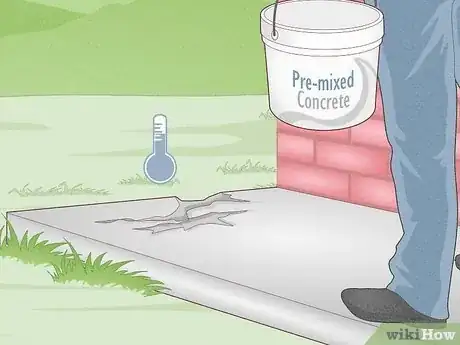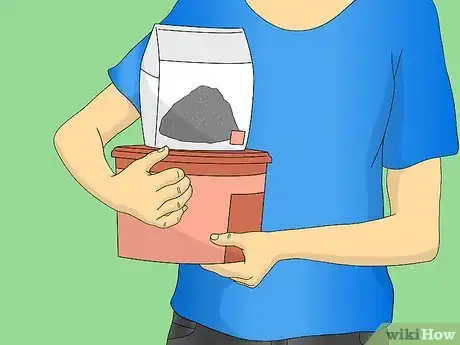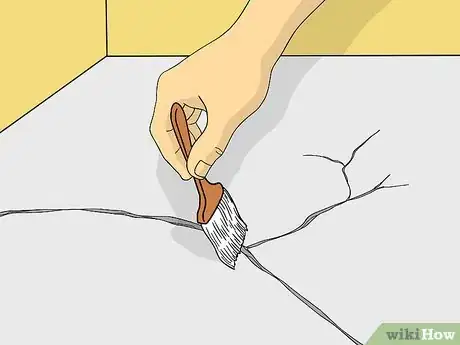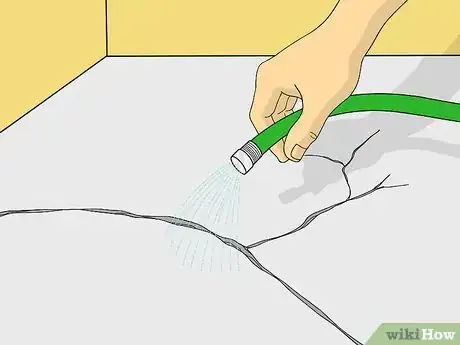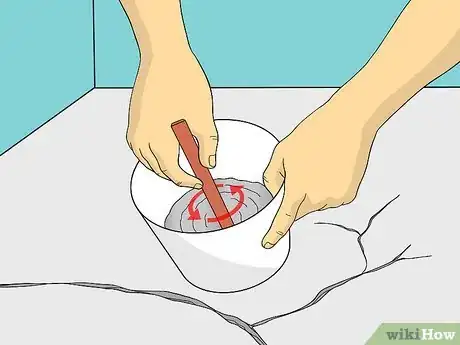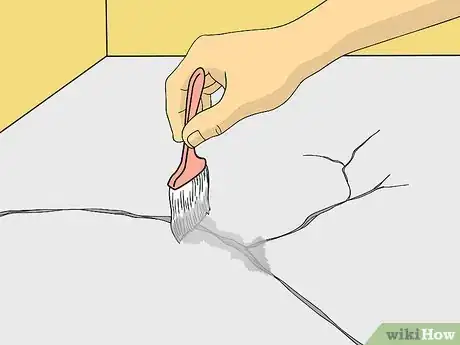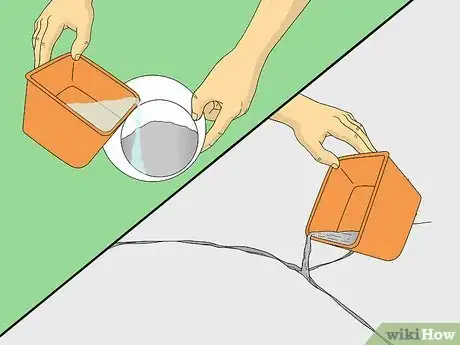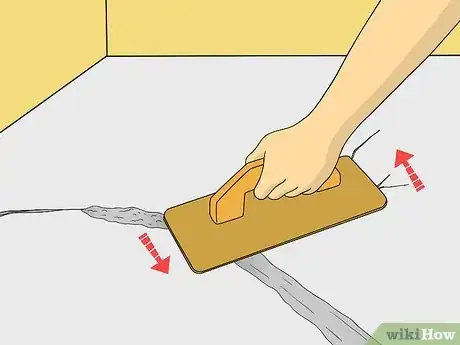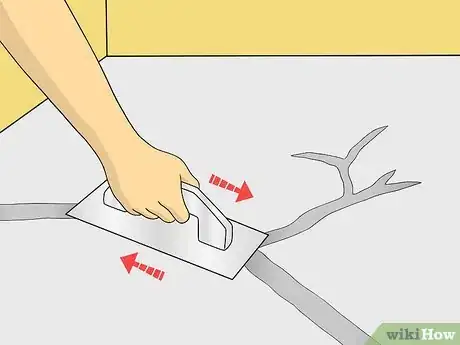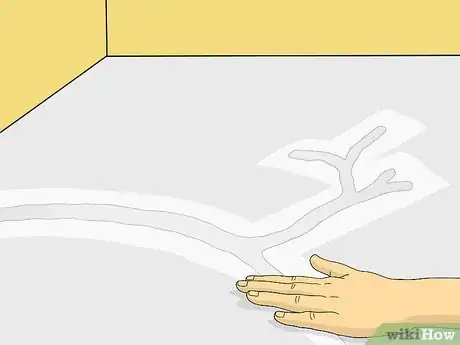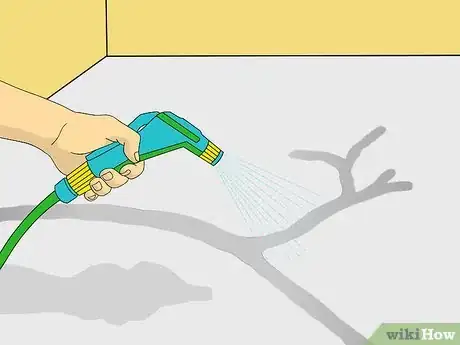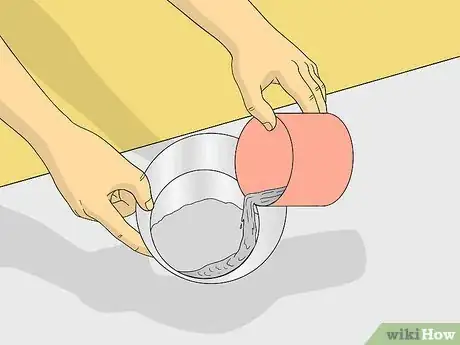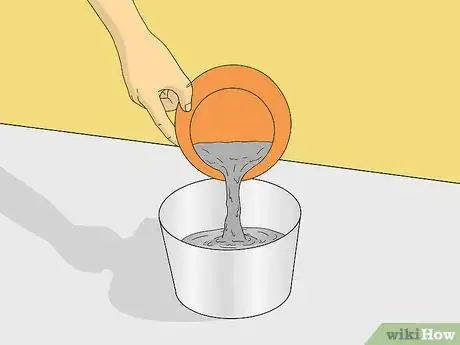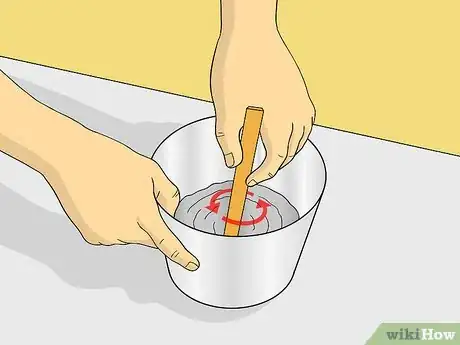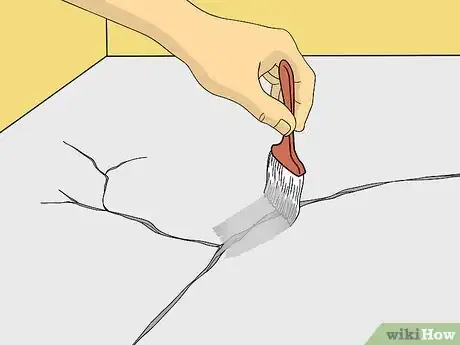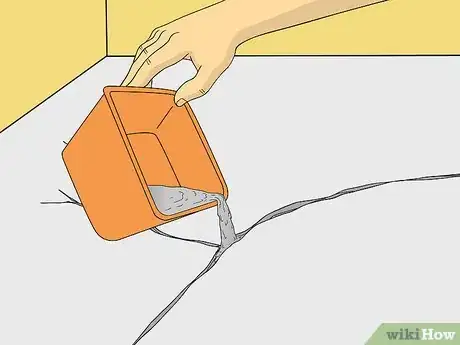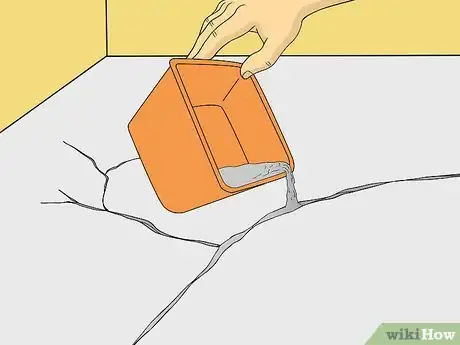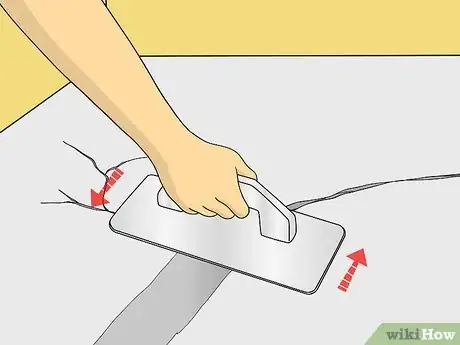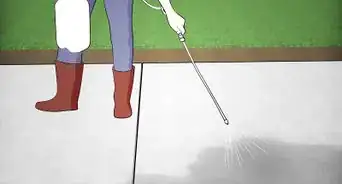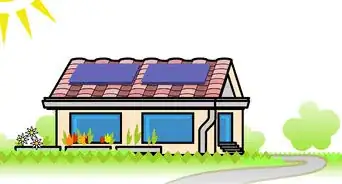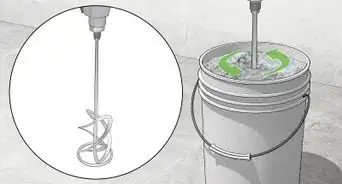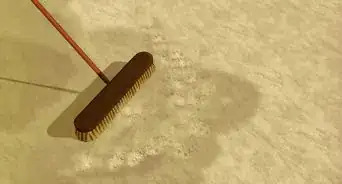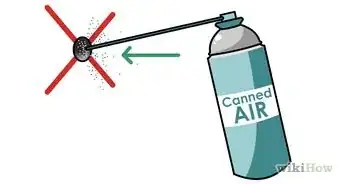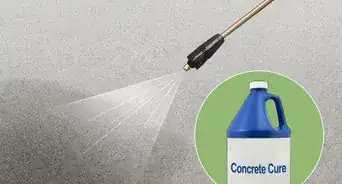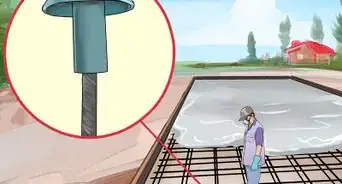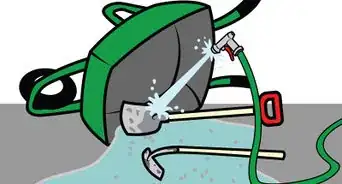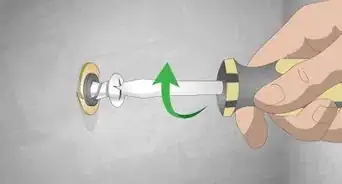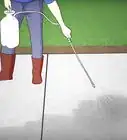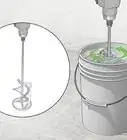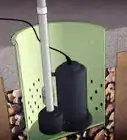This article was co-authored by Gerber Ortiz-Vega. Gerber Ortiz-Vega is a Masonry Specialist and the Founder of GO Masonry LLC, a masonry company based in Northern Virginia. Gerber specializes in providing brick and stone laying services, concrete installations, and masonry repairs. Gerber has over four years of experience running GO Masonry and over ten years of general masonry work experience. He earned a BA in Marketing from the University of Mary Washington in 2017.
wikiHow marks an article as reader-approved once it receives enough positive feedback. In this case, several readers have written to tell us that this article was helpful to them, earning it our reader-approved status.
This article has been viewed 433,983 times.
Concrete is usually made of cement, water, gravel, and sand. This combination creates a very hard, durable surface. However, cracks and damage can occur. Fixing concrete takes a number of materials because it does not readily adhere to other concrete. The mixture and formation relies on a chemical reaction that stops once dried. If you need to patch a concrete surface or pour new concrete on top of old concrete, you must invest in a strong bonding agent and a concrete patching mix. If all precautions are taken, you can create a repair that will last a few decades.
Steps
Patching a Concrete Surface
-
1Wait for a cool, overcast day to do your concrete repairs. This is the best time to adhere the concrete because it takes longer for the water to dry out, and it has more time to react with the cement.[1]
-
2Buy concrete patching material. It is available in a pre-mixed form or by buying the separate ingredients in bulk. If you haven't adhered concrete to concrete before, it is a good idea to go with the pre-mixed version, which only requires that you add water.
- Buying the raw materials, gravel, Portland cement and sand is considerably cheaper than buying pre-mixed concrete patching. If you are patching a deep hole, you can use 1-inch (2.54-cm) gravel, otherwise, use very fine gravel.
- Mix the dry materials in a ratio of 3 parts gravel to 2 parts sand to 1.5 parts cement in a bucket. This is sometimes listed as 3 to 2 to 1. A higher amount of cement will create a stronger material. There will be more of chemical reaction between the cement and water, which will create more crystals and a harder structure.
Advertisement -
3Sweep the concrete surface carefully. You must remove all loose stones, or the bonding agent and cement will not reach the surface of the concrete.[2]
-
4Dust the surface thoroughly after you have swept. You can use a blower or a soft brush; wipe away the dirt that is stuck to the surface.
-
5Rinse the concrete. Sprinkle an even amount of water onto the surface with a hose attachment. Stop adding water before you create standing water on the surface.[3]
- This will stop the porous concrete from sucking the moisture out of the bonding agent and concrete bonding material.
-
6Create cement paint. Mix Portland cement, which is available at most hardware stores, with water. Stir the 2 ingredients together until they form the consistency of wet paint.
- You can also buy an acrylic bonding agent to use in place of the homemade cement paint. They are made of resin and can be either added to your patching concrete or applied like the cement paint. Follow the instructions on the can or bottle very carefully, as many of the products have different application instructions and drying times.
-
7Apply a thin layer of the cement paint to the old, damp concrete with a paint brush. Do this right before you plan to pour the new concrete patch onto your old concrete surface.
-
8Add the water to the homemade or pre-mixed concrete patch just before applying. Mix it well. Pour the patch into holes and cracks or pour a 3/8-inch (1-cm) layer to flat surfaces.
-
9Wipe the surface of the concrete with a wooden float. Apply it to the surface with a back and forth motion until the pieces of gravel have sunk below the surface. The sand and cement should rise to the surface.[4]
-
10Allow water to bead and rise to the surface. It will evaporate on its own. For a smoother finish, wait until the concrete is hardening and almost plastic in texture, then apply a smooth back and forth motion with a metal trowel.
-
11Cover your patch with plastic sheeting while it dries. This will keep as much water as possible within the concrete mix and it will bond better.
-
12Spray the new concrete with a coat of water every day for 4 to 7 days. This will keep the chemical reaction going and make the new concrete stronger.
Pouring a New Slab over an Existing One
This method works best when you have someone to help you with the mixing and brushing. Do not attempt large areas until you have practiced and achieved success on smaller learning areas.
-
1Mix one part polybond with 4 parts water.
-
2Add the mixture to clean dry cement powder.
-
3Mix until a slurry like consistency is achieved.
-
4Brush this slurry mix onto old concrete slab.
-
5Pour new concrete while mixture is still wet.
-
6Keep applying slurry mix ahead of new concrete as you go.
-
7Finish concrete in your usual manner.
Expert Q&A
Did you know you can get expert answers for this article?
Unlock expert answers by supporting wikiHow
-
QuestionWhat's the best way to clean off tools after mixing concrete?
 Gerber Ortiz-VegaGerber Ortiz-Vega is a Masonry Specialist and the Founder of GO Masonry LLC, a masonry company based in Northern Virginia. Gerber specializes in providing brick and stone laying services, concrete installations, and masonry repairs. Gerber has over four years of experience running GO Masonry and over ten years of general masonry work experience. He earned a BA in Marketing from the University of Mary Washington in 2017.
Gerber Ortiz-VegaGerber Ortiz-Vega is a Masonry Specialist and the Founder of GO Masonry LLC, a masonry company based in Northern Virginia. Gerber specializes in providing brick and stone laying services, concrete installations, and masonry repairs. Gerber has over four years of experience running GO Masonry and over ten years of general masonry work experience. He earned a BA in Marketing from the University of Mary Washington in 2017.
Masonry Specialist & Founder, GO Masonry LLC
-
QuestionWhat is the quickest-curing material (not setting but curing) for filling a small hole before putting epoxy paint over the floor?
 Community AnswerTry Bondo. It feels like putty, sets quickly and sticks to wood and other material. As it is an epoxy itself, it will form a good base for epoxy paint. Although it's advertised for auto body work, it can be used in construction projects as well. You can get it at Home Depot.
Community AnswerTry Bondo. It feels like putty, sets quickly and sticks to wood and other material. As it is an epoxy itself, it will form a good base for epoxy paint. Although it's advertised for auto body work, it can be used in construction projects as well. You can get it at Home Depot. -
QuestionWhen the cement base is dry under the paving stones, can I use additional concrete to fill the cracks between the pavers?
 Community AnswerYou can, it won't adhere to anything, though. One usually employs grout for such tasks. Since your pavers are exposed to the sun, they heat and cool, which makes them act as if they're breathing. Select backfill, sand, or the cheap stuff the quarry sells (the dust stuff, though it's not dust). These tolerate the heating and cooling better, and allow the pavers to shift as needed. You can use concrete, no question, it's just not the best choice for long term durability.
Community AnswerYou can, it won't adhere to anything, though. One usually employs grout for such tasks. Since your pavers are exposed to the sun, they heat and cool, which makes them act as if they're breathing. Select backfill, sand, or the cheap stuff the quarry sells (the dust stuff, though it's not dust). These tolerate the heating and cooling better, and allow the pavers to shift as needed. You can use concrete, no question, it's just not the best choice for long term durability.
Things You'll Need
- Portland cement
- Water
- Paint brush
- Stirring stick
- Water hose
- Pre-mixed concrete patching compound
- Sand
- Gravel
- Bucket
- Metal trowel
- Plastic drop cloth
- Wood float
- Broom
- Blower or soft brush
References
- ↑ https://www.familyhandyman.com/masonry/concrete-repair/garage-floor-resurfacing-fix-a-pitted-garage-floor/
- ↑ https://www.lowes.com/n/how-to/simple-concrete-repairs
- ↑ https://www.familyhandyman.com/masonry/concrete-repair/garage-floor-resurfacing-fix-a-pitted-garage-floor/
- ↑ https://www.thisoldhouse.com/more/how-to-patch-concrete-floor
- http://www.askthebuilder.com/B123_Long_Lasting_Concrete_Repair.shtml
- http://www.askthebuilder.com/123_Concrete_Repairs_101.shtml
About This Article
To adhere concrete to concrete, make sure you choose a cool, overcast day to do your repairs. Begin by carefully sweeping away all loose stones and dirt and rinsing the concrete to prepare the surface. Then, if you want to patch the concrete, apply a thin layer of cement paint, pour a well-mixed concrete patch into the holes, and wipe the surface with a wooden float. Cover the patch with plastic sheeting while it dries and finish by spraying water on the new concrete for 4 to 7 days. For more advice, including how to pour a new slab over an existing one, keep reading!
